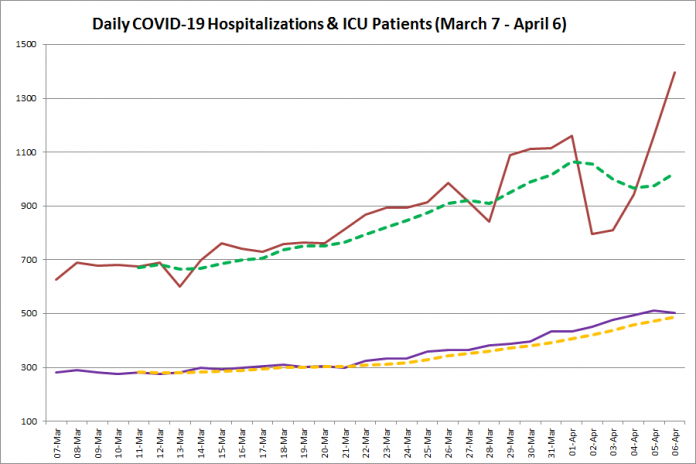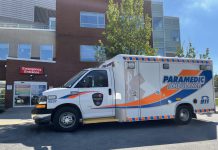
The Ontario government is imposing a province-wide stay-at-home order for the next four weeks, effective at 12:01 a.m. on Thursday, April 8th.
Premier Doug Ford made the announcement on Wednesday afternoon (April 7) at Queen’s Park, at a media conference along with health minister Christine Elliott, solicitor general Sylvia Jones, and Ontario’s chief medical officer of health Dr. David Williams.
“The reality is, despite everything we’ve done so far, the COVID-19 situation in Ontario is getting worse as these new variants continue to spread,” Ford said. “Our hospitals are reaching capacity, and patients in the GTA must now be sent to other parts of the province for care. In fact, we learned yesterday morning that admissions to ICUs in the past week are increasing faster than the worst-case scenario predicted by our experts.”
“I’m hearing from more and more of our hospital CEOs about the situation in our hospitals and ICUs. I can’t stress this enough: things are extremely, extremely serious right now and I’m extremely concerned.”
The stay-at-home order requires everyone to remain at home except for essential purposes, such as going to the grocery store or pharmacy, accessing health care services (including getting vaccinated), for exercise close to home and with the people you live with, or for work that cannot be done remotely.
Schools and child care will remain open for in-person learning and care and in public health regions where they are permitted to remain open, with strict safety measures in place.
In addition to the stay-at-home order, only essential businesses such as grocery stores and pharmacies will remain open for in-person shopping, with big box and discount retailers restricted to selling groceries, household cleaning supplies, pharmacy items (pharmaceutical, health care ,and personal care items), and pet care supplies only.
Non-essential retail stores will be allowed to offer curbside pickup and delivery between the hours of 7 a.m. and 8 p.m., with delivery allowed from 6 a.m. to 9 p.m.
Access to shopping malls will be restricted to limited specified purposes, including access for curbside pickup and delivery (via appointment), with one single designated location inside
the shopping mall, and any number of designated locations outside the shopping mall.
Outdoor garden centres and plant nurseries, and indoor greenhouses that sell to the public, can remain open with a 25 per cent capacity limit and a restriction on hours of operation.
Other stores that can remain open for in-person shopping by appointment, subject to a 25 per cent capacity limit and only allowed to be open between 7 a.m. and 8 p.m., include safety supply stores, medical and health care stores, rental and leasing services, optical stores that sell prescription eyewear to the public, motor vehicle and watercraft dealers, vehicle and equipment repair and rental, and mobile phone retailers for sales or support.
The Ontario government has also announced it is expanding its vaccination efforts.
Beginning next week, education workers who provide direct support to students with special education needs across the province, and all education workers in select hot spot areas, will be eligible to register for vaccination.
Vaccinations will begin during the April break starting with priority neighbourhoods in Toronto and Peel, then rolling out to priority neighbourhoods in other hot spot regions, including York, Ottawa, Hamilton, Halton, and Durham. This will be followed by a rollout across the province as supply allows.
People living in regions with the highest rates of transmission will be moved to the top of the list to receive a vaccine, starting with Toronto and Peel and later to other “hot spot” regions. Mobile clinics will administer vaccines to people 18 and over in high-risk congregate settings, residential buildings, faith-based locations, and locations occupied by large employers in hot spot neighbourhoods. Pop-up clinics will also be set up in these neighbourhoods, including at faith-based locations and community centres.
As of Friday (April 9), the government will also extend eligibility for COVID-19 vaccination appointments through its provincial booking system to people 50 and over in those public health regions with high-risk areas.

Today’s announcement comes less than a week after the government’s decision to apply a four-week long “emergency brake” shutdown to the entire province in an attempt to control the spread of the more contagious and virulent COVID-19 variants.
The shutdown, which went into effect last Saturday, did not include a stay-at-home order — contrary to a recommendation from Ontario’s COVID-19 science advisory table released last week. It also allowed all retail businesses to remain open for in-person shopping, although with reduced capacities.
There was widespread criticism the shutdown did not go far enough, compounded after reports that large crowds gathered at malls over the Easter long weekend. Earlier this week, the medical officers of health for Toronto, Ottawa, and Peel — three of the regions with the highest daily case counts — called on the government to impose a stay-at-home order.
Over the past seven days, Ontario has averaged almost 3,000 new cases each day, including 3,215 new cases today. More than half of the infections are in people under the age of 39. There are now almost 1,400 Ontarians hospitalized with COVID-19, including more than 500 people in intensive care units — the highest number since the beginning of the pandemic.

This story has been updated with additional information about the provincial state of emergency.


























